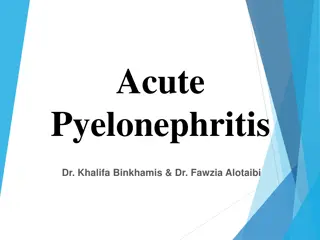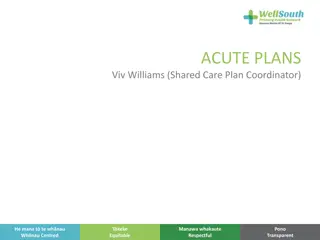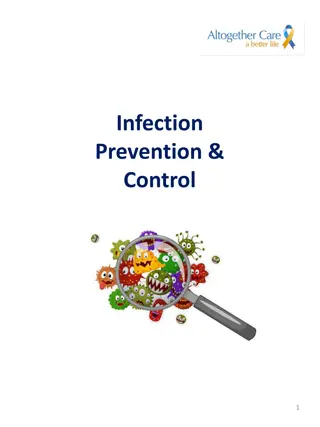Diagnosis and Management of Acute HIV Infection
Guideline aims to recognize the risks, signs, and symptoms of acute HIV infection and to promote HIV testing in individuals presenting with flu-like symptoms or viral syndromes. It provides recommendations for diagnostic testing, treatment, and prevention services to improve patient health and reduc
0 views • 19 slides
Strategies to Address Acute Malnutrition and High Mortality Rates in Children Under 5
Malnutrition in children under 5, specifically acute malnutrition, is a pressing issue in the Western Cape. This presentation outlines the current strategies, multisector engagement, causes, and impacts of acute malnutrition. It delves into the classifications of malnutrition, including severe and m
1 views • 38 slides
Acute orofacial pain
Acute orofacial pain is often associated with dental issues, ranging from dentinal pain to periodontal pain. The pain can be moderate to severe, with various triggers such as mechanical stimulation and changes in osmotic pressure. This pain is prevalent in adults and can spread to different areas of
1 views • 49 slides
Overview of Acute Gingival Diseases
Acute gingival diseases encompass various conditions such as Necrotizing Ulcerative Gingivitis, Necrotizing Ulcerative Periodontitis, Necrotizing Ulcerative Stomatitis, and others. Necrotizing Ulcerative Gingivitis (NUG) is a microbial disease primarily affecting the gingiva, characterized by necros
5 views • 67 slides
Managing Acute Chest Syndrome in Sickle Cell Disease
A case study of a 31-year-old male with sickle cell disease presenting in the emergency department with a pain crisis. The patient has a history of avascular necrosis, priapism, NSTEMI, cholecystectomy, and previous acute chest syndrome. Explore the patient's symptoms, past medical history, and reco
7 views • 19 slides
Understanding Infection: Causes, Signs, and Nursing Management
Learn about the definition of infection, common causes, general and specific signs and symptoms, nursing assessment for foot ulcers and pressure injuries, as well as nursing interventions for infection prevention and management. Dive into the stages of infection, general and specific signs and sympt
0 views • 24 slides
Overview of Acute Cholecystitis: Diagnosis, Severity Grading, and Treatment
Acute calculous cholecystitis is a common digestive disease with varying treatment perspectives. The Tokyo Guidelines 2018 provide criteria and severity grading for the diagnosis of acute cholecystitis. Diagnosis involves local and systemic signs of inflammation along with specific imaging findings.
0 views • 18 slides
Understanding Leukemia: Causes, Types, and Treatment Options
Leukemia is a group of blood disorders characterized by abnormal white blood cell production. Factors like genetics, environment, and mutations in DNA play a role in its development. Acute leukemia requires urgent treatment due to rapid cell growth, while chronic leukemia progresses more slowly. The
1 views • 20 slides
Comprehensive Acute Care at Home Service for Older Adults
This service, led by a dedicated consultant geriatrician and multidisciplinary team, focuses on providing acute care at home for older individuals at risk of hospital admission. The inclusion criteria, referral process, and interventions offered are outlined, emphasizing the aim of maintaining patie
0 views • 5 slides
Global Nutrition Prevalence Rates in Children and Women
This content highlights the prevalence rates of acute malnutrition, severe acute malnutrition (SAM), moderate acute malnutrition (MAM), childhood stunting, acute malnutrition based on MUAC and edema, and acute malnutrition in pregnant and lactating women. The data is based on various criteria such a
9 views • 37 slides
Comprehensive Guide to Acute Knee Examination in Urgent Care
This detailed guide covers the essential components of the acute knee exam conducted in an urgent care setting by Dr. Gregory Jones, including chief complaints, anatomy, examination techniques, ligament assessments, practical aspects, and more. The examination process involves assessing functional l
1 views • 27 slides
Understanding Inflammation and Its Characteristics
Inflammation is the response of tissues to harmful agents, categorized as acute or chronic. Acute inflammation is rapid and short-lived, while chronic inflammation is insidious and prolonged. Chemical mediators play a crucial role in both forms, leading to tissue necrosis. The five cardinal signs of
3 views • 27 slides
Comprehensive Overview of Acute Abdomen Assessment and Management
This detailed guide covers the definition, general approach, history taking, physical examination, investigations, diagnosis, and management of acute abdomen cases. Learn about common causes, such as acute appendicitis, bowel obstruction, and medical conditions. Real-life scenarios illustrate differ
2 views • 15 slides
Understanding Gout: Pathophysiology, Stages, and Treatment Options
Gout is characterized by acute inflammatory arthritis due to sodium urate crystal deposits. Untreated gout can lead to complications like tophi, nephrolithiasis, and joint inflammation. The disease progresses through stages: acute, asymptomatic hyperuricemia, intercritical, and chronic gout. Treatme
0 views • 13 slides
Understanding Acute Pyelonephritis: Risk Factors, Etiology, and Management
Acute pyelonephritis is a bacterial infection of the kidney associated with serious complications. This article discusses the definition, risk factors, etiology, and pathogenesis of the condition. It also covers the clinical presentation, diagnosis, management, and prevention strategies for acute py
0 views • 18 slides
Cognitive Stimulation Therapy in Post-Acute Care: A Pilot Study
Cognitive Stimulation Therapy (CST) is an evidence-based group intervention designed for individuals with mild to moderate cognitive impairment. It aims to enhance cognitive functioning through various activities such as executive functioning tasks, multi-sensory stimulation, and reminiscence work.
0 views • 9 slides
Inpatient Management of Severe Acute Malnutrition Training Course 2011
This training course focuses on inpatient management of severe acute malnutrition, teaching procedures outlined in the national Community-Based Management of Severe Acute Malnutrition Guidelines. The training aims to reduce case fatality rates significantly and is designed for physicians, senior nur
0 views • 9 slides
Acute Malnutrition - Fluid Management and Treatment Overview
Acute malnutrition, particularly severe acute malnutrition (SAM), requires careful fluid management and a structured treatment approach involving stabilization, transition, and rehabilitation phases. This condition results from inadequate dietary intake or acute infections, leading to severe wasting
0 views • 23 slides
Comprehensive Guide to Infection Prevention and Control in Healthcare Facilities
This comprehensive guide outlines the objectives, structure, responsibilities, common sources of infection, and principles of infection prevention and control in healthcare facilities. The program aims to minimize the risk of healthcare-associated infections, enhance healthcare worker adherence to I
0 views • 55 slides
Comprehensive Treatment Guidelines for Acute Ischemic Stroke
In the management of acute ischemic stroke, the primary goals are to reduce secondary brain damage, maintain adequate perfusion, and prevent recurrent strokes by managing risk factors. Treatment includes maintaining tissue oxygenation, correcting volume status and electrolytes, managing blood glucos
0 views • 20 slides
Understanding Standardized Infection Ratio (SIR) in Healthcare-Associated Infections
The Standardized Infection Ratio (SIR) is a key measure used to monitor healthcare-associated infections (HAIs) at different levels. It compares observed HAIs with predicted values based on specific risk factors. An SIR > 1 indicates more infections than predicted, an SIR = 1 means observed equals p
0 views • 19 slides
Understanding the Epidemic of C. Difficile Infection: Insights and Implications
C. Difficile infection is a growing concern, with a significant impact on public health in the United States. High rates of infection and mortality, particularly among the elderly, highlight the urgent need for effective prevention and management strategies. The burden of C. Difficile infection exte
0 views • 59 slides
Understanding Abnormal Liver Function Tests: Acute vs. Chronic Approach
Comprehensive discussion on assessing patients with abnormal liver test results, focusing on distinguishing between acute and chronic liver conditions. Covers diagnostic workup, patient cases, and differential diagnosis, emphasizing the importance of patient history, physical examination, and key di
0 views • 16 slides
Enhanced Eyecare Services for Optometrists in North Staffordshire
North Staffordshire Minor Eye Conditions Service (MECS) has been re-launched to provide a comprehensive managed service for treating common eye problems by local community optometrists. MECS offers a broader scope than the previous Acute Eye pathway, enabling the management of both acute and non-acu
0 views • 19 slides
Review of Care for Patients with Acute Bowel Obstruction: Recommendations and Key Findings
This review assesses the quality of care provided to patients aged over 16 years with acute bowel obstruction. Significant delays were identified in the care pathway, from imaging requests to availability of operating theatres. Recommendations include prompt CT scans with intravenous contrast for de
0 views • 32 slides
Understanding Acute HIV Infection and PrEP Implementation in Latin America
PrEP is a vital HIV prevention strategy; however, individuals with Acute HIV Infection (AHI) may inadvertently start PrEP due to the limitations of current screening methods. The ImPrEP project in Brazil, Mexico, and Peru aims to evaluate the feasibility of providing PrEP to MSM and transgender indi
0 views • 15 slides
Infection Guidelines for Data Entry Scenarios
Guidelines for entering different infection scenarios into a database, including pre-implant infections, colonization cases, and handling multiple organisms in cultures. Clear instructions on what constitutes a major infection adverse event and how to accurately document various infection situations
0 views • 18 slides
Comprehensive Guide to Creating and Understanding Acute Care Plans
This comprehensive guide provides detailed information on creating and understanding acute care plans, including the purpose of an acute plan, who needs one, what information can be written in an acute plan, examples of baseline clinical parameters, alerts to more detailed plans, and insights into c
0 views • 17 slides
Developing a Surgical Site Infection Bundle for Improved Patient Outcomes
Developing a comprehensive Surgical Site Infection (SSI) bundle to reduce infection rates, including interventions like preoperative chlorhexidine baths, standardized antibiotic protocols, and targeted prophylactic measures. By implementing these strategies, the aim is to lower infection rates below
0 views • 24 slides
Epidemiology of Hepatitis B and C in Florida: 2019 Data Analysis
The Department of Health in Florida has released the 2019 data on the epidemiology of Hepatitis B and C as of January 21, 2021. The report includes information on acute and chronic cases, technical notes on case definitions, and changes in national case definitions in 2020. Acute cases require speci
0 views • 35 slides
Trends in Parasitic Copepod Infection Among Juvenile Salmonids in WVP Reservoirs Study
Study conducted by the Oregon Department of Fish and Wildlife researchers to investigate trends in parasitic copepod infection among juvenile salmonids in WVP reservoirs. The study focuses on the prevalence and intensity of infection on the gills, comparing infection levels between stream-rearing an
0 views • 12 slides
Overview of Hepatitis B Infection in Ireland: Epidemiology, Transmission, and Prevention
Hepatitis B infection is a viral liver disease transmitted through various means such as contact with infected body fluids. The virus can lead to acute or chronic infection, potentially causing severe liver complications. Vaccination programs and lifelong treatment options aim to manage and prevent
0 views • 30 slides
Understanding Pain Management: Acute vs. Chronic Pain and Interventional Therapies
Pain is a complex experience that can be acute or chronic, requiring different treatment approaches. Acute pain alerts us to potential injury, while chronic pain lasts longer and affects quality of life. Management options range from medical and psychological treatments to advanced interventions and
0 views • 26 slides
Comprehensive Guide to Infection Prevention and Control
Understanding the essentials of infection prevention and control is crucial in healthcare settings. This guide covers key topics such as basic principles, standard precautions, specific infections, surveillance, and prevention methods. It explores the chain of infection, factors making individuals s
0 views • 65 slides
Approach to Acute Flaccid Paralysis in Children: Evaluation and Management
Acute muscular weakness in children is a neurological emergency defined by sudden onset muscle weakness or paralysis in less than 5 days. When evaluating a child with acute flaccid paralysis, consider factors like onset rhythm, associated symptoms, and past medical history. A thorough physical and n
0 views • 45 slides
Children's Hospital @ Home: Acute Nursing Care in Tower Hamlets
Providing acute nursing care for children at home from 8 am to 10 pm, the Children's Hospital @ Home in Tower Hamlets offers services such as IVABs, NGT re-insertion, acute assessment, wheeze management, and home-based phototherapy. The initiative aims to reduce hospital stays, minimize admissions f
0 views • 7 slides
Guidelines for Suspecting and Managing 2019-nCoV (COVID-19) Infection
Guidelines provided by the Ministry of Public Health in Lebanon highlight the criteria for suspecting a 2019-nCoV (COVID-19) infection, including illness onset and exposure factors. It outlines symptoms to look for, such as fever and respiratory issues, as well as exposure scenarios like travel to C
0 views • 23 slides
Importance of Infection Prevention and Control in Healthcare
Infection Prevention and Control is crucial to safeguarding against the spread of harmful microorganisms in healthcare settings. This comprehensive guide covers the definition of infections, types of microorganisms, modes of transmission, the immune system's role, factors predisposing to infections,
0 views • 7 slides
Prospective Cohort Study on Acute HIV Infection in Bangkok
The study focuses on initiating combination antiretroviral therapy for all HIV-infected individuals to preserve the CD4+ T cell population, restrict viral reservoir seeding, and minimize viral evolution. Rapid suppression of HIV viraemia in patients could lead to potential candidates for future cure
0 views • 12 slides
Environmental Issues in Infection Prevention: Addressing Challenges and Best Practices
Addressing environmental issues in infection prevention is crucial for maintaining a safe healthcare facility. The challenges include room cleaning during hospitalization, disinfection post-discharge/transfer, time constraints, cost containment, ongoing education, competency assessment, and outcome
0 views • 19 slides







































